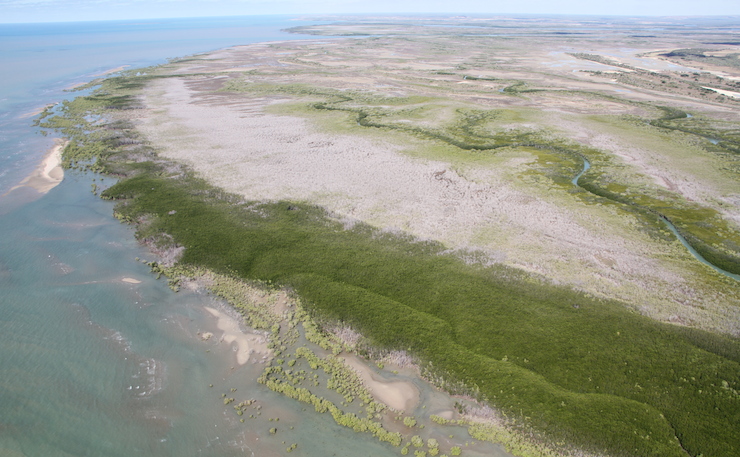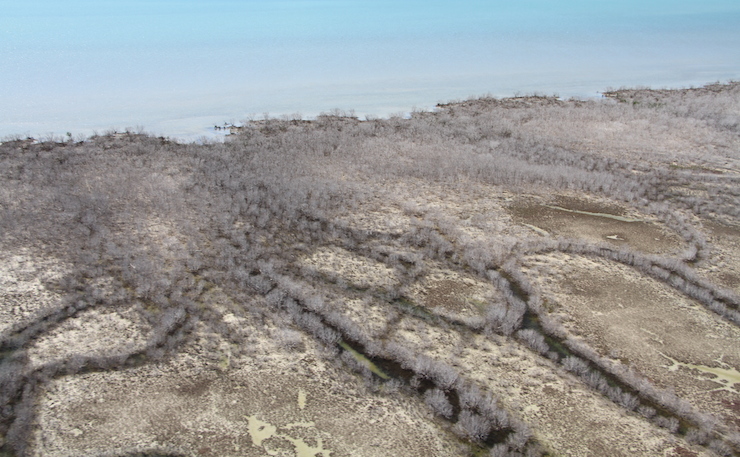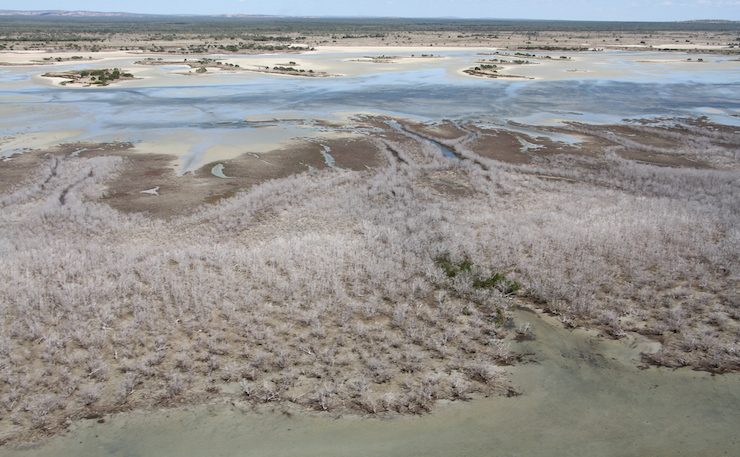First old growth forest, then the Great Barrier Reef, and now massive swathes of mangroves. It’s been a terrible year for the Australian environment. Thom Mitchell reports.
Late last year, vast swathes of verdant-green mangroves started to die off around the fringe of the Gulf of Carpentaria. Within the space of roughly a month, in late November and early December, the best part of 7,000 hectares had turned a ghostly white.
The keeling mangroves are reminiscent of the bleached Great Barrier Reef, which began to turn white around the same time. In Tasmania, ancient forests afflicted by an inferno they had not adapted to cope with would die smouldering in February.
These devastating events all appear to be harbingers of a climate-changed world.
Scientists are talking more and more about ‘state changes’, where dominant ecosystems come unstuck, and are displaced by ecological communities better suited to the new normal.
A leading expert, Professor Norman Duke says that what’s happened to the mangroves along the Gulf of Carpentaria is “easily in the same league” as the more publicised disasters on the Reef and in Tasmania.
“They’re the ugly duckling of the marine world, but they’re very important,” the James Cook University scientist said.
Mangroves perform important ecological functions. They’re often called the kidneys of the sea, and they act as a buffer between the terrestrial and marine environments on shores that would otherwise shift and erode.

Across the 700 kilometres studied – stretching west from Normanton, Queensland, and into the Northern Territory – Prof Duke said around 9 per cent of the mangroves appear to have died off. In some pockets the die-back is as high as 25 per cent.
Prof Duke said that it’s too early to fully understand what’s occurred, and more intensive study is needed. He’s surveyed the scene from a helicopter, but is working mostly off low-definition satellite imagery and an often-volunteer presence on the ground.
Even at this early stage, climate change appears to have played a part.
“The climate of the severe drought seems to have been the trigger on this occasion,” Prof Duke said. “And that co-occurred, if you like, with the hot water in the sea that has resulted in the coral bleaching on the Great Barrier Reef,” he said.
Both phenomena are linked to the El Nino weather system that’s just passed, which was augmented by climate change. In a briefing for journalists, the Bureau of Meteorology said rainfall has “been below average to very-much-below average along the entire Gulf of Carpentaria coast” over the past two monsoon seasons.
“The low rainfall has coincided with record-high sea surface temperatures,” the Bureau said. “Sea surface temperatures across the northern tropics were the highest on record during the 2014-15 wet season, with the following 2015-16 wet season breaking the record again.” Air temperatures have also been elevated.
“The warmer temperatures have been caused by El Niño combined with global warming. While El Niño is typically associated with warmer-than-normal conditions around Australia, the impact of global warming has seen many atmosphere and sea surface temperature records broken by considerable margins.”
Prof Duke said we might see a large-scale and long-term loss of mangrove forests as a result of events like this, although he added that the dominant species may recover after defoliation. The estuaries mangroves trace inland have not been as badly affected, but there’s a risk that the ecology of the ravaged shoreline could undergo a ‘state change’.
“Now that you’ve got the mangrove area dead along the sea-edge shoreline,” Prof Duke said, “the new seedlings can’t grow back quickly enough to secure that bank from eroding”.
“If you get a cyclone, severe storm or heavy wave action during a sort of five year bracket of time – maybe more – you’re going to get a significant erosion.”

Prof Duke said that “mangrove systems are an alternate state to salt plains and flats” and that “rainfall seems to be the influence that causes them to be one or another”.
While there’s a natural interchange between the two systems, Prof Duke said “normally you don’t see such an extreme expression of die-back from mangroves”.
He said there’s a risk of “a conversion of most of the intertidal zone – not all, but most – into salt plains and mud flat, and salt marsh vegetation”.
“Where normally it might be decades of change, we’ve got it mostly in one month,” he said.
“I don’t think we should be alarmist about it, but we should be aware of it so that we know that what we are doing is affecting climate, and what the consequences are going to be.
“If it is about losing mangrove areas” – which ironically, along with coastal wetlands, hold about fifty times more carbon than tropical forests by area – “we need to make a decision,” Prof Duke said.
“Is that what we want? Do we want to lose those habitat and shoreline benefits? It’s the same question as with the Reef and those Tasmanian forests.
“We are at a stage in our human history where we actually have some potential to control that decision, but the problem would be in the future we have less opportunities to make that decision,” he said.
Donate To New Matilda
New Matilda is a small, independent media outlet. We survive through reader contributions, and never losing a lawsuit. If you got something from this article, giving something back helps us to continue speaking truth to power. Every little bit counts.





